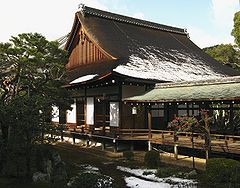
Daikaku-ji
Encyclopedia

Shingon Buddhism
is one of the mainstream major schools of Japanese Buddhism and one of the few surviving Esoteric Buddhist lineages that started in the 3rd to 4th century CE that originally spread from India to China through traveling monks such as Vajrabodhi and Amoghavajra...
temple in Ukyō-ku
Ukyo-ku, Kyoto
is one of the eleven wards in the city of Kyoto, in Kyoto Prefecture, Japan. The word , as opposed to , refers to the western half of the ancient capital of Heiankyō – the palace faced south, hence west was to the right...
, a western ward
Wards of Japan
A is a subdivision of one of the cities of Japan that is large enough to have been designated by government ordinance. Wards are used to subdivide each city designated by government ordinance...
in the city of Kyoto
Kyoto
is a city in the central part of the island of Honshū, Japan. It has a population close to 1.5 million. Formerly the imperial capital of Japan, it is now the capital of Kyoto Prefecture, as well as a major part of the Osaka-Kobe-Kyoto metropolitan area.-History:...
, Japan
Japan
Japan is an island nation in East Asia. Located in the Pacific Ocean, it lies to the east of the Sea of Japan, China, North Korea, South Korea and Russia, stretching from the Sea of Okhotsk in the north to the East China Sea and Taiwan in the south...
. The main images are of the Five Wisdom Kings, centered on Fudō
Acala
In Vajrayana Buddhism, Ācala is the best known of the Five Wisdom Kings of the Womb Realm. He is also known as Ācalanātha, Āryācalanātha, Ācala-vidyā-rāja and . The Sanskrit term ācala means "immovable"; Ācala is also the name of the eighth of the ten completion stages of the Bodhisattva path...
. It was a villa of Emperor Saga
Emperor Saga
was the 52nd emperor of Japan, according to the traditional order of succession. Saga's reign spanned the years from 809 through 823.-Traditional narrative:...
, and later, retired Emperor Go-Uda
Emperor Go-Uda
Emperor Go-Uda was the 91st emperor of Japan, according to the traditional order of succession...
conducted his cloistered rule
Cloistered rule
The Insei system , or cloistered rule, was a specific form of government in Japan during the Heian period. In this bifurcated system, an Emperor abdicated, but he retained power and influence. The emperors who withdrew to live in monasteries continued to act in ways which were intended to...
from here. A school of ikebana
Ikebana
is the Japanese art of flower arrangement, also known as .-Etymology:"Ikebana" is from the Japanese and . Possible translations include "giving life to flowers" and "arranging flowers".- Approach :...
, the Saga Goryū, maintains its headquarters in the temple.
History
Daikaku-ji was founded in the early Heian periodHeian period
The is the last division of classical Japanese history, running from 794 to 1185. The period is named after the capital city of Heian-kyō, or modern Kyōto. It is the period in Japanese history when Buddhism, Taoism and other Chinese influences were at their height...
. The temple was established in 876
876
Year 876 was a leap year starting on Sunday of the Julian calendar.- Births :* Henry the Fowler, the duke of Saxony from 912 and king of the Germans from 919 until his death...
, thirty years after the death of Emperor Saga, by his first daughter, Empress Masako, who gave it its name. It was a monzeki
Monzeki
Monzeki were Japanese Buddhist priests of aristocratic or imperial lineage. The term was also applied to the temples in which they lived....
temple, that is, by tradition imperial princes were appointed abbot of the temple.
See also
- List of Buddhist temples in Kyoto
- List of National Treasures of Japan (ancient documents)
- List of National Treasures of Japan (writings)
- For an explanation of terms concerning Japanese Buddhism, Japanese Buddhist art, and Japanese Buddhist temple architecture, see the Glossary of Japanese BuddhismGlossary of Japanese BuddhismThis is the glossary of Japanese Buddhism, including major terms the casual reader might find useful in understanding articles on the subject. Words followed by an asterisk are illustrated by an image in one of the photo galleries...
.
External links
- 旧嵯峨御所 大覚寺 門跡 Kyū Sagano Gosho Dakaku-ji Monzeki(in Japanese)
- Saga Goryū school of ikebana (in Japanese)
- Kyoto National Museum -- "Treasures of Daikaku-ji," including portrait of Go-Uda and the former-emperor's will

